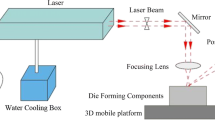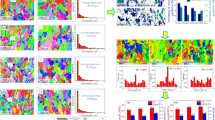Abstract
Pulsed current treatment was introduced into the laser impact microforming technology to improve the formability of laser impact forming. A pulsed current pretreatment–assisted laser impact microforming technology is proposed, and the formability and mechanism of such composite technology are discussed. In this study, the mechanical properties of H62 brass before and after pulse treatment were tested. The effect of pulsed current treatment on the formability of the material under high strain rate was studied by a laser impact free microbulging experiment. Moreover, the mechanism of pulsed current influence on the material’s formability was analyzed from the aspects of microstructure, texture evolution process, and grain size and morphology. Results showed that the elongation of the material was increased obviously, the flow stress during the tensile process was decreased significantly after pulsed current treatment, and the fracture form of the material gradually evolved from brittle fracture to ductile fracture. The forming height of samples under high strain rate improved greatly which may be due to the high-density pulsed current treatment that significantly alleviated the dislocation entanglement in the material. Owing to the weaker orange-peel effect which is induced by smaller recrystallized grains and lower maximum density of texture, the surface quality of formed parts after pulsed current treatment increased remarkably. In addition, the more uniform section thickness distribution of formed parts was observed, which may stem from obviously refined grains after pulsed current treatment improved the fluidity of the grains in a high–strain rate deformation process.

















Similar content being viewed by others
Availability of data and materials
Not applicable.
References
Guo N, Sun CY, Fu MW (2017) Size effect affected deformation characteristics in micro deep drawing of TWIP domed-bottom cups. Procedia Eng 207:2072–2077. https://doi.org/10.1016/j.proeng.2017.10.1066
Samardzic V, Geskin ES, Atanov GA, Semko AN, Kovaliov A (2007) Liquid impact based material micro-forming technology. J Mater Eng Perform 16:375–389. https://doi.org/10.1007/s11665-00.7-9063-x
Yu HP, Sun LC, Zhang X, Wang SL, Li CF (2017) Experiments on electrohydraulic forming and electromagnetic forming of aluminum tube. Int J Adv Manuf Technol 89:3169–3176. https://doi.org/10.1007/s00170-016-9261-5
Hu XY, Daehn GH (1996) Effect of velocity on flow localization in tension. Acta Mater 44:1021–1033. https://doi.org/10.1016/1359-6454(95)00228-6
Ye YX, Feng YY, Lian ZC, Hua YQ (2015) Mold-free fs laser shock micro forming and its plastic deformation mechanism. Opt Lasers Eng 67:74–82. https://doi.org/10.1016/j.optlaseng.2014.11.002
Choi DC, Kim HS (2020) Performance evaluation of laser shock micro-patterning process on aluminum surface with various process parameters and loading schemes. Opt Lasers Eng 124:105799. https://doi.org/10.1016/j.optlaseng.2019.105799
Fan Y, Wang Y, Vukelic S, Yao YL (2005) Wave-solid interactions in laser-shock-induced deformation processes. J Appl Phys 98:104904–104904-11. https://doi.org/10.1063/1.2134882
Li J, Gao H, Cheng GJ (2010) Forming limit and fracture mode of microscale laser dynamic forming. J Eng Ind 132:1–10. https://doi.org/10.1115/1.4002546
Gao H, Cheng GJ (2010) Laser-induced high-strain-rate superplastic 3-D microforming of metallic thin films. J Microelectromech S 19:273–281. https://doi.org/10.1109/JMEMS.2010.2040947
Liu HX, Jiang CK, Liu F, Ma YJ, Wang X (2019) Numerical and experimental investigations of laser shock hydraulic microforming for thin-walled foils. Thin-Walled Struct 143:106219. https://doi.org/10.1016/j.tws.2019.106219
Hu YX, Luo MS, Yao ZQ (2016) Increasing the capability of laser peen forming to bend titanium alloy sheets with laser-assisted local heating. Mater Des 90:364–372. https://doi.org/10.1016/j.matdes.2015.10.128
Troitskii OA, Likhtman VI (1963) Anisotropy of the effect of electron beam and irradiation on the deformation process of zinc single crystals in the brittle state. Dokl Akad Nauk SSSR 148:332
Song JH, Lee J, Hwang I, Kim YB, Choi S, Lee GA, Kang MK (2013) Effect of pulsed electric current on the tensile properties of DP type ultra-high strength steel sheets. Appl Mech Mater 389:284–288. https://doi.org/10.4028/www.scientific.net/AMM.389.284
Yang JJ, Li Y, Xue P, Yu WX (2013) Effects of impulse current on plastic behavior of 2A12 and 7A04 aluminum alloys. Adv Mater Res 716:320–324. https://doi.org/10.4028/www.scientific.net/AMR.716.320
Zhao YG, Ma BD, Guo HC, Ma J, Yang Q, Song JS (2013) Electropulsing strengthened 2GPa boron steel with good ductility. Mater Des 43:195–199. https://doi.org/10.1016/j.matdes.2012.06.060
Salandro WA, Bunget C, Mears L (2011) Electroplastic modeling of bending stainless steel sheet metal using energy methods. J Eng Ind 133:041008. https://doi.org/10.1115/1.4004589
Jie K, Low TSE, Stephen RN, Li XH, Geng YB, Luo AA, Tang GY (2016) Abnormal texture development in magnesium alloy Mg–3Al–1Zn during large strain electroplastic rolling: effect of pulsed electric current. Int J Plast 87:86–99. https://doi.org/10.1016/j.ijplas.2016.09.004
Bao WK, Chu XG, Lin SX, Gao J (2015) Experimental investigation on formability and microstructure of AZ31B alloy in electropulse-assisted incremental forming. Mater Des 87:632–639. https://doi.org/10.1016/j.matdes.2015.08.072
Tang ZJ, Du H, Lang LH, Jiang SS, Chen J, Zhang JT (2018) Experimental investigation into the electropulsing assisted punching process of 2024T4 aluminum alloy sheet. J Mater Process Technol 253:86–98. https://doi.org/10.1016/j.jmatprotec.2017.11.011
Konkova T, Mironov S, Korznikov A, Korznikova G, Myshlyaev MM, Semiatin SL (2015) Annealing behavior of cryogenically-rolled Cu–30Zn brass. J Alloys Compd 648:858–863. https://doi.org/10.1016/j.jallcom.2015.05.287
Yu T, Deng DW, Wang G, Zhang HC (2016) Crack healing in SUS304 stainless steel by electropulsing treatment. J Clean Prod 113:989–994. https://doi.org/10.1016/j.jclepro.2015.12.060
Tang DW, Zhou BL, Cao H, He GH (1993) Thermal stress relaxation behavior in thin films under transient laser-pulse heating. J Appl Phys 73:3749–3752. https://doi.org/10.1063/1.352907
Li C, Tan H, Wu WM, Zhao S, Zhang HB (2016) Effect of electropulsing treatment on microstructure and tensile fracture behavior of nanocrystalline Ni foil. Mater Sci Eng A 657:347–352. https://doi.org/10.1016/j.msea.2016.01.075
He WW, Li F, Zhang HY, Chen HQ, Guo HG (2019) The influence of cold rolling deformation on tensile properties and microstructures of Mn18Cr18 N austenitic stainless steel. Mater Sci Eng A 764:138245. https://doi.org/10.1016/j.msea.2019.138245
Fabbro R, Fournier J, Ballard P, Devaux D, Virmont J (1990) Physical study of laser-produced plasma in confined geometry. J Appl Phys 68:775–784. https://doi.org/10.1063/1.346783
Sprecher AF, Mannan SL, Conrad H (1986) Overview no. 49: on the mechanisms for the electroplastic effect in metals. Acta Metall 34:1145–1162. https://doi.org/10.1016/0001-6160(86).90001-5
Zhang L, Xu WJ, Liu CS, Ma X, Long J (2017) Quantitative analysis of surface roughness evolution in FCC polycrystalline metal during uniaxial tension. Comput Mater Sci 132:19–29. https://doi.org/10.1016/j.commatsci.2017.02.018
Rittel D, Roman I (1988) Tensile fracture of coarse-grained cast austenitic manganese steels. Metall Mater Trans A 19(9):2269–2277. https://doi.org/10.1007/BF02645050
Mishra S, Yazar KU, More A, Kumar L, Lingam R, Reddy HV, Prakash O, Suwas S (2020) Elucidating the deformation modes in incremental sheet forming process: insights from crystallographic texture, microstructure and mechanical properties. Mater Sci Eng A 139311:139311. https://doi.org/10.1016/j.msea.2020.139311
Zhang WW, Yao YL (2002) Micro scale laser shock processing of metallic components. J Eng Ind 124:369–378. https://doi.org/10.1115/1.1445149
Xu Z, Tang G, Ding F, Tian S, Tian H (2007) The effect of multiple pulse treatment on the recrystallization behavior of Mg-3Al-1Zn alloy strip. Appl Phys A Mater Sci Process 88:429–433. https://doi.org/10.1007/s00339-007-4007-8
Xu ZH, Tang GY, Tian SQ, Ding F, Tian HY (2007) Research of electroplastic rolling of AZ31 Mg alloy strip. J Mater Process Technol 182:128–133. https://doi.org/10.1016/j.jmatprotec.2006.07.019
Conrad H, Guo Z, Sprecher AF (1990) Effects of electropulse duration and frequency on grain growth in Cu. Scr Met Mater 24(2):359–362. https://doi.org/10.1016/0956-716X(90)90270-Q
Estrin Y, Krausz AS, Krausz K (1996) Unified constitutive laws of plastic deformation. Australia: Med Chem. https://doi.org/10.1016/B978-012425970-6/50003-5
Taylor GI (1934) A theory of the plasticity of crystals. Z Krist-Cryst Mater 89(1–6):375–385. https://doi.org/10.1524/zkri.1934.89.1.375
Maity T, Prashanth KG, Balçi Ö, Wang Z, Jia YD, Eckert J (2018) Plastic deformation mechanisms in severely strained eutectic high entropy composites explained via strain rate sensitivity and activation volume. Compos Part B 150:7–13. https://doi.org/10.1016/j.compositesb.2018.05.033
Hart EW (1967) Theory of the tensile test. Acta Metall 15(2):351–355. https://doi.org/10.1016/.0001-6160(67)90211-8
Li Z, Voisin T, McKeown JT, Ye JC, Braun T, Kamath C, King WE, Wang YM (2019) Tensile properties, strain rate sensitivity, and activation volume of additively manufactured 316L stainless steels. Int J Plast 120:395–410. https://doi.org/10.1016/j.ijplas.2019.05.009
Tiamiyu AA, Szpunar JA, Odeshi AG (2019) Strain rate sensitivity and activation volume of AISI 321 stainless steel under dynamic impact loading: grain size effect. Mater Charact 154:7–19. https://doi.org/10.1016/j.matchar.2019.05.027
Funding
The work reported in this paper was supported by the National Natural Science Foundation of China (No. 51675243).
Author information
Authors and Affiliations
Contributions
Haokun Zhang wrote the first draft of the paper. All authors revised and approved the final version of the manuscript.
Corresponding author
Ethics declarations
Ethics approval
Not applicable.
Consent to participate
Not applicable.
Consent for publication
Not applicable.
Competing interests
The authors declare no competing interests.
Additional information
Publisher’s note
Springer Nature remains neutral with regard to jurisdictional claims in published maps and institutional affiliations.
Rights and permissions
About this article
Cite this article
Zhang, H., Wang, X., Ma, Y. et al. Formability and mechanism of pulsed current pretreatment–assisted laser impact microforming. Int J Adv Manuf Technol 114, 1011–1029 (2021). https://doi.org/10.1007/s00170-021-06964-0
Received:
Accepted:
Published:
Issue Date:
DOI: https://doi.org/10.1007/s00170-021-06964-0




